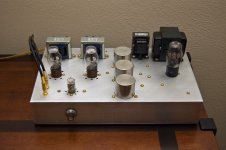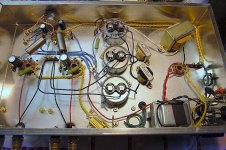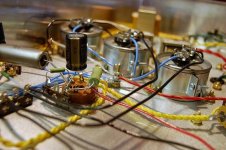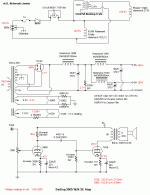I've been wanting to do a Darling Amp for the longest time as I have several Military 1626 and 8532/6J4 tubes and all the parts needed. What I don't like about all the Darlings I've seen is that the left/right tubes all share the same cathode resistor and bypass. I have downloaded at least 50 different Darling versions, and I like the attached one best as a start due to its simplicity. I see some problems though...
1 No grid stoppers, so ill add those as carbon composition
2 Shared cathode resistors, so ill separate those and double the values
3 No leak resistor after the volume control, ill add maybe a 500k there just to be safe.
4 And my big pet peeve is when people don't mark the expected final B+ voltage right on the schematic. So ill put this PS into the Duncan PSD program to see what voltage it would be using these parts.
5 The reservoir cap (first cap) should probably be grounded first at the CT then bring a wire over to the next cap to keep the first loop smaller?
6 Ill set the filament voltage by experiment by selecting the best dropping resistor in a closed loop to hit 12.6 while hot.
Any other items on this I should look out for? Any Darling veteran advice?

1 No grid stoppers, so ill add those as carbon composition
2 Shared cathode resistors, so ill separate those and double the values
3 No leak resistor after the volume control, ill add maybe a 500k there just to be safe.
4 And my big pet peeve is when people don't mark the expected final B+ voltage right on the schematic. So ill put this PS into the Duncan PSD program to see what voltage it would be using these parts.
5 The reservoir cap (first cap) should probably be grounded first at the CT then bring a wire over to the next cap to keep the first loop smaller?
6 Ill set the filament voltage by experiment by selecting the best dropping resistor in a closed loop to hit 12.6 while hot.
Any other items on this I should look out for? Any Darling veteran advice?

Last edited:
Here’s mine I built years ago. Still enjoy it to this day. Great little amps!
Attachments
Here’s mine I built years ago. Still enjoy it to this day. Great little amps!
Nice. Ill split out the supply as well I have plenty of chokes. I have to ask why you have all the bucking going on, was it just to adapt the power Transformer you had on hand?
Yep. I was getting about 325V B+ without adding the little $10 bucking transformer. The power transformer is way too big, but it’s what I had on hand. Easy to implement and it was only that one additional part.
Had to put that big 25W resistor on the 12V filament to keep it down as well. My mains voltage at the time averaged about 123V but would go up to nearly 128V in the evening.
Had to put that big 25W resistor on the 12V filament to keep it down as well. My mains voltage at the time averaged about 123V but would go up to nearly 128V in the evening.
Last edited:



